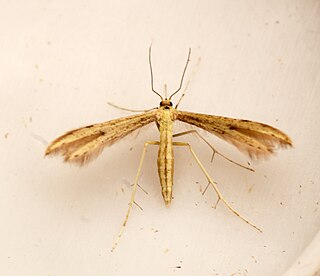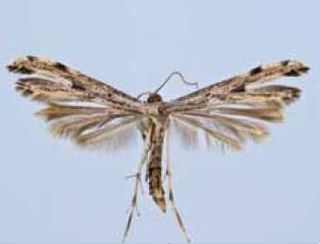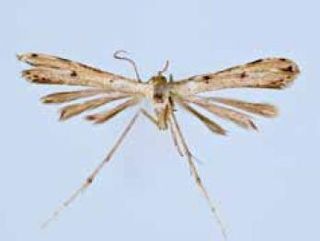
Adaina microdactyla is a moth of the family Pterophoridae first described by Jacob Hübner in 1813. Also known as the hemp-agrimony plume, it is found in Africa, Asia and Europe.
Stenoptilia pallistriga is a moth of the family Pterophoridae described by William Barnes and James Halliday McDunnough in 1913. It is known from Dominica, Ecuador, Jamaica, Paraguay and Suriname. It is also found in the United States in Florida and Mississippi.

Adaina is a genus of moths in the family Pterophoridae. The genus was erected in 1905 by J. W. Tutt. Several of its species have gall-inducing larvae, such as Adaina primulacea, of which the larvae induce stem galls on Chromolaena odorata, and Adaina microdactyla, which induces stem galls on Eupatorium cannabinum.

Adaina ambrosiae is a moth of the family Pterophoridae. It is found in North America from California east to Florida and north to Ontario. It is also known from Bermuda, Costa Rica, Jamaica, Puerto Rico and the Virgin Islands.
Hellinsia lacteodactylus is a moth of the family Pterophoridae described by Vactor Tousey Chambers in 1873. It is found in North America, including Florida, Mississippi, Kentucky, North Carolina, Colorado, Nova Scotia and British Columbia.

Hellinsia paleaceus is a moth of the family Pterophoridae described by Philipp Christoph Zeller in 1873. It is found in North America, including Florida, Mississippi Maryland, Montana, Texas, California, Nebraska, New Mexico and south-eastern Canada. It has also been recorded from Puerto Rico.

Hellinsia inquinatus is a moth of the family Pterophoridae. It is found in North America, including Florida, Mississippi, Oklahoma, Tennessee, Maryland, Alabama, Texas, Missouri, Colorado and Arizona. It has also been recorded from Hispaniola, Mexico, Puerto Rico and St. Thomas Island.

Oidaematophorus eupatorii, the eupatorium plume moth or Joe Pye plume moth, is a moth of the family Pterophoridae. It is found in North America, including Florida, Mississippi, Iowa, New York, California and Vancouver Island. It is also known from Mexico, Guatemala and Panama.

Emmelina buscki, also known as the tropical morning glory plume moth, is a moth of the family Pterophoridae. It was described by William Barnes and Arthur Ward Lindsey in 1921. It is found in North America, Central America, and northern South America.
Hellinsia elliottii is a moth of the family Pterophoridae. It is found in North America, including Mississippi, New York, Iowa, Quebec, Alberta and Ontario.

Adaina simplicius is a moth of the family Pterophoridae. It is found in the United States, Brazil, Costa Rica, Ecuador, Paraguay and Puerto Rico. It was introduced to South Africa for study as a biological control agent for Eupatorium macrocephalum.

Adaina primulacea is a moth of the family Pterophoridae. It is known from Taboga Island in the Gulf of Panama, Costa Rica and southern Florida, United States. It is probably widespread throughout the Neotropics, including the West Indies and Central and South America.

Adaina montanus is a moth of the family Pterophoridae. It is found in North America, including south-eastern Canada and the north-eastern United States.

Adaina zephyria is a moth of the family Pterophoridae. It was described by William Barnes and Arthur Ward Lindsey in 1921. It is widely distributed in the Americas, ranging from California (USA) through Mexico and Central America to South America (records from Venezuela, Ecuador, Peru, Bolivia, Brazil, Paraguay, and Argentina.

Adaina thomae is a moth of the family Pterophoridae. It is known from Florida, Mexico, the Caribbean, Venezuela, and Brazil.

Adaina perplexus is a moth of the family Pterophoridae. It is found in the United States, including the Florida Everglades. It has also been recorded from Cuba and Trinidad.

Adaina planaltina is a moth of the family Pterophoridae. It is found in the Federal District of Brazil.
Adaina praeusta is a moth of the family Pterophoridae. It is only known from Puerto Rico.

Adaina obscura is a moth of the family Pterophoridae. It is found in Costa Rica.

Adaina ipomoeae is a moth of the family Pterophoridae. It is found in Cuba, Jamaica, Puerto Rico, Guadeloupe, the Dominican Republic, Grenada, and Florida.
















